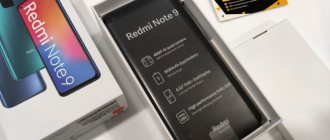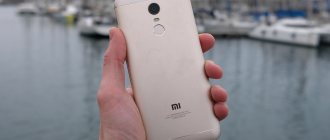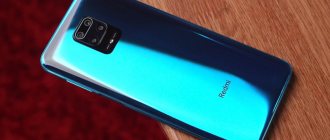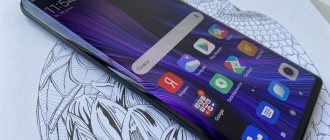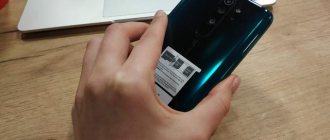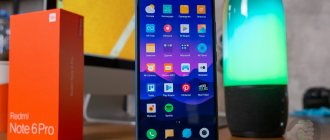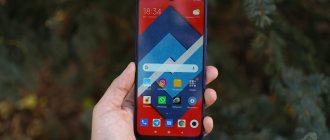After the release of Redmi Note 8, a similar model, but with a slightly different name - Xiaomi Redmi Note 8T - the Chinese company launched in European markets. Despite the letter “T” appearing in the name, in general it is the same device, but with NFC support.
Can this model stand out as something special among its budget competitors? For review, I was provided with a Redmi Note 8T with MIUI Global 10.3.1. The version designed for the European market is equipped with 3 GB of RAM and 32 GB of internal storage memory; there is also a model with 4 GB and 64 GB of memory, respectively, on sale.
Buy Redmi Note 8T 3/32 GB on AliExpress
Buy Redmi Note 8T 4/64 GB on AliExpress
Characteristics of Xiaomi Redmi Note 8T
| Display | 6.3-inch IPS LCD with 19.5:9 aspect ratio, Full HD+ resolution (2340×1080), 88.3% screen with Gorilla Glass 5 |
| CPU | Qualcomm Snapdragon 665 (4-2.0 GHz Kryo 260 Gold and 4-1.8 GHz Kryo 260 Silver) |
| Graphic arts | Adreno 610 |
| RAM | 3/4 GB |
| ROM | 32/64/128 GB, expandable via microSD up to 256 GB |
| Cameras | Main: 48-MP main (Samsung QW1), f/1.8, 26 mm, 0.8 micron, PDAF + 8-MP ultra-wide, f/2.2 + 2-MP macro, f/2.4 + 2 -MP depth sensor, f/2.4. Shooting 4k video at 30 fps, Full HD video at 30/60 frames and slow motion at 120 frames per second. Front: 13 MP, f/2.0, 0.9 micron, Full HD video at 30 fps. |
| Headphone jack | Yes |
| Battery | 4000 mAh, 18 W, Quick Charge 4.0 fast charging and support USB-PD, USB-C |
| IP rating | No, splash-proof nanocoating |
| Sensors | Proximity, ambient lighting in the screen, accelerometer, gyroscope, electronic compass, vibration motor, IR blaster |
| Communications and connections | LTE FDD: B1/B2/B3/B4/B5/B7/B8/B20/B28 LTE TDD: B38/B40 WCDMA: B1/B2/B4/B5/B8 GSM: B2/B3/B5/B8 Wi-Fi ( 2.4 GHz and 5 GHz): 802.11a/b/g/n/ac Wi-Fi Direct / Wi-Fi Display Bluetooth 5.0 |
| Dimensions and weight | 161.1?75.4?8.6 mm, 200 g |
Connection
- 2 x NanoSIM;
- Bluetooth 5.0;
- Wi-Fi dual-band 802.11 a/b/g/n/ac;
- A-GPS, GLONASS;
- NFC.
The main advantage of the Note 8T over its competitors and the regular Note 8 is the presence of an NFC module. The device works absolutely correctly with Google Pay, reads and tops up the Troika card, and in general allows you to fully enjoy the delights of contactless payments.
The speaker here is loud and clear, there are no problems with communication reception. The phone supports all current wireless interfaces, including 5 GHz Wi-Fi and normally functioning VoLTE and Wi-Fi Calling. There is also Band 3+7 frequency aggregation, which is not available in Note 7 and Note 8 Pro, which means you will always have the highest possible data exchange speed on 4G networks. There are no complaints about the operation of GPS and navigation applications; the phone quickly connects to satellites and maintains a stable connection even in an apartment.
Features and differences
Xiaomi Redmi Note 8T is the latest model in Xiaomi's Redmi lineup. The phone combines good performance, four customizable cameras, long battery life, expandable storage via microSD card, and fast charging. All this from about 11 thousand rubles.
However, the main difference between this model is NFC support. But, if you do not belong to the category of people who use NFC, then you can choose another, more suitable model based on your needs. For example, Redmi Note 7 with the same performance, but without an ultra-wide lens, and it will cost you less.
What's included:
- Telephone;
- Silicone Case;
- charging adapter 18 W;
- Type-C cable;
- key for removing the SIM card.
The Note 8T compares favorably with the basic version by the inclusion of a fast 5V/3A charger (the regular Note 8 has a 10 W adapter). The Chinese didn’t skimp on the protective case either; it’s quite high quality – it feels good in the hand and completely covers the protruding camera.
Design and appearance
Externally, Redmi Note 8T is similar to Note 7. Its front glass panel is curved with a small drop-shaped cutout on top, the frame on the sides is metal, in addition, both panels are covered with Gorilla Glass 5. The volume rocker and power button are easy to press and very convenient for use. use.
The only thing I didn’t like about the design is that the camera module protrudes far beyond the body, which is why the lenses get scratched and when you put the phone on a hard surface, it wobbles. The rear panel of the Redmi Note 8T also houses a capacitive fingerprint scanner. During testing, it worked flawlessly. Definitely, this is a more reliable identification option than an in-screen reader.
On the bottom edge of the device you will find a USB-C port, a speaker and a 3.5 mm headphone jack; the presence of the latter will please those who have not switched to Bluetooth headphones. This model is sold in three color options - Starscape Blue, Moonshadow Gray and Moonlight White.
Verdict, competitors
What I liked about Redmi Note 8T:
- beautiful case, Gorilla Glass 5, splash protection;
- large and high-quality IPS screen;
- good universal camera;
- excellent battery life, fast charging;
- there is Type-C and a 3.5 mm jack;
- separate slot for MicroSD, IR sensor, NFC.
Flaws:
- There is no LED notification indicator;
- auto brightness curve.
Controversial points:
- The frames and body dimensions are slightly larger than those of the Note 8.
The Note 8T is a great smartphone considering its price. With NFC support, a mini-jack, a triple card tray, a cool camera and a 4000 mAh battery, it will easily satisfy the needs of the majority of not too demanding users who need a modern phone within 10-15 thousand rubles.
Smartphone display
The 6.3-inch panel of Xiaomi Redmi Note 8T is made using IPS TFT technology and has a resolution of 2340×1080 pixels and 409 ppi. The minimum and maximum brightness is at a good level, although, of course, visibility in the sun will not be very comfortable. The selfie camera is hidden in the teardrop-shaped cutout.
In the settings you will find a reading mode that changes the color temperature of the display to a warmer one, we can also set a schedule for turning it on and off. It is possible to adjust the contrast (automatic, high and standard) and colors (default, warm). A nice addition is the dark mode, which changes the design of the phone interface. This is a solution that we usually find on AMOLED screens rather than IPS.
Cameras Redmi Note 8T
The phone boasts a new quad-camera system. On the back is a 48-megapixel main lens, the same as on the Note 7. In standard mode, photos taken with the 48-megapixel lens have 12-megapixel resolution. However, with this camera you can get an image with a resolution of 8000x6000 pixels, although it will be excessively sharp.
In my opinion, the standard mode in low light gives the best results, and the photos taken in this case weigh much less. The presence of an ultra-wide lens is good news, but the macro camera, which only has a 2-megapixel resolution, gives very mediocre results.
Since the Xiaomi Redmi Note 8T does not have a dedicated telephoto lens, portrait mode uses a depth sensor, the performance of which I did not like. The phone had difficulty distinguishing the background from the object, and in low light the frames were not of the best quality.
The work of the front camera is not satisfactory, except that the bokeh effect does not accurately determine the edges every time. Selfie lovers will be pleased with the presence of a panoramic selfie mode. With it, you can easily fit a large number of friends into the frame.
The main camera of Redmi Note 8T can shoot video with a resolution of 4K (speed 30 frames per second), and Full HD (speed 30/60 fps). Considering the price of the phone, the video quality is not bad, if you do not pay attention to excessive sharpness.
The cameras have a user-friendly and easy-to-use app. True, when you switch from one to another or to night mode, you feel that there is non-flagship performance here. But the camera has a pro-mode that allows you to control the sensor.
What else can the phone do?
Let's take a look at other possibilities: two SIM cards are in place, navigation is fast, and Wi-Fi is also okay. Bluetooth 4.2 here is an old version, but you can survive it. Most importantly, there is NFC!
To protect your data, you can use the fingerprint scanner located on the back; it works quickly and you can’t find fault with it. Thank you for not embedding it into the screen. Alternatively, you can enable face unlock through the front camera: not so reliable, but fast.
Software
The Xiaomi Redmi Note 8T smartphone runs on Android Pie with Xiaomi's custom MIUI 10 overlay. MIUI is similar to iOS in many ways. You won't find an app drawer here, and the icon shapes aren't consistent. The only thing I don't like about MIUI is the presence of pre-installed applications and a large number of advertisements.
If you are looking for an alternative to the Redmi Note 8T for about the same money, but definitely with the Android One operating system, then there are several options available on the market. For example, Xiaomi Mi A3 has the same universal camera and runs on Android One, but it does not have NFC. There is also the Moto G7 Power with the Android One operating system and NFC, although the device does not have a 48-megapixel camera, but only a 12-megapixel lens.
Hardware performance
The Xiaomi Redmi Note 8T phone runs on an eight-core processor from Qualcomm - Snapdragon 665 (4? Kryo 260 Gold, 2 GHz + 4? Kryo 260 Silver, 1.8 GHz). The device has 3 GB (in the test version) or 4 GB of RAM. The amount of internal memory is 32 GB, 64 GB or 128 GB, depending on the version. In AnTuTu Benchmark, this chipset scored 162,779 points.
In testing, the device mostly ran smoothly, although there were some slight lags in the interface or animations that were noticeable from time to time. In this class, theoretically, the device has the right to this, however, in my subjective opinion, smartphones with pure Android, available for similar or slightly more money, work more smoothly. With 3 GB of RAM, the device can store 3.4 tabs in memory without rebooting.
The new Redmi Note 8T handles simple games easily and a little less well with more demanding ones. The “Game Acceleration” mode helps here and, for example, PUBG ran without problems for me.
Installing custom recovery
There are two popular recovery options: TWRP and Orange Fox . I prefer the second one, as it works more stably with this phone model. Download from the official website of Orange Fox and you will also need to download ADB. Preferably on drive C:/ Next, we need to place the downloaded Orange Fox in the installed ADB
ADB folder, hold down Shift and at the same time right-click inside the folder and select Run, open a command window , or you can simply launch it using the shortcut that will be offered to you when installing ADB
Enter the command fastboot flash recovery “your recovery“.img example fastboot flash recovery recovery.img
Sound and multimedia
The Xiaomi Redmi Note 8T has one speaker, located on the bottom edge, and sounds surprisingly clear and loud. You won't miss any calls thanks to the high volume converter when watching YouTube videos and music videos will be a pleasant experience.
After connecting the headphones via the 3.5 mm jack, we have at our disposal a number of sound settings known from other Xiaomi smartphones. The quality through the headphones is quite nice.
Communication: there is NFC! NFC!
The key advantage of Redmi Note 8T over cheaper models of the same Redmi brand and most devices from the same price category from other companies is the presence of NFC .
Wireless payments via smartphone work great in Russia, you just need to spend a couple of minutes setting up Google Pay. Actually, there is nothing to talk about NFC itself - the technology has been in active use for a year now. I’m just recording the fact that NFC is present in the inexpensive Note 8T.
The rest of the connection is virtually standard. There are two separate SIM card slots, support for Wi-Fi 802.11ac and Bluetooth 5.0.
Among the unusual things, I’d like to note support for aptX and aptX HD . Listening to music through wireless headphones is pleasant. I tested it on AirPods and FiiO EW1 headphones, which I reviewed earlier . I advise you to read it, there is an extremely interesting set of Hi-Fi player and headphones for reasonable money.
Communication and security
The fingerprint scanner in Redmi Note 8T, as I already wrote, works without reservations, and the facial recognition system also does a good job. After activating the “Rise to Wake” option in the display settings, the phone will automatically start lighting up the screen when the camera recognizes our face even in the dark and takes us straight to the desktop. Everything works smoothly, at a very high level, and most importantly, conveniently.
GPS also does not have any reservations, when NFC is the icing on the cake. I’m glad that Xiaomi noticed the growing popularity of contactless payments in our country and decided to add this module to a device costing less than 15 thousand. Payment also works without reservations.
WiFi here is dual-band, although Bluetooth version 4.2, instead of 5.0, and location determination is carried out using A-GPS, GLONASS and Beidou. The set of sensors includes: accelerometer, proximity sensor, light sensor, magnetometer, gyroscope and gravity sensor, there is also an FM radio.
Download the firmware
Download the firmware from the official website. There are two versions Plus and a regular one, download the regular one. We transfer the phone to custom recovery. Press the volume up and power buttons and wait for Orange Fox . Next we need to do a wipe, that is, erase everything from the phone. Go to wipe
Check the underlined boxes and wipe – move the slider. We are slowly approaching completion. We need to transfer the downloaded firmware to the smartphone. Next, open My Computer and see the connected disk device there - this is our recovery. We copy our firmware there. Go to Files and find it. Next, tap on it and move the slider, after which our firmware will begin to install. This will take 5 minutes. Root rights and install Google camera as desired!
Enjoy it for your health. I can tell you from my personal experience. I've been using the firmware for 7 months now and haven't had any problems. PUBG plays without freezes, unlike Miui. I'm happy as an elephant)) To make it easier for you to understand the installation of recovery and firmware, I will attach another video. Good luck to you!
Autonomy of Xiaomi Redmi Note 8T
Redmi Note 8T is equipped with a 4000 mAh battery, the charge of which lasts for a whole working day. Recharge your device using fast 18 W charging. It took me 30 minutes to charge the device from 5 to 40%; after an hour the level reached 80%. I usually had at least 30% battery power left at the end of the day.
However, competing gadgets already offer models with a similar price and large energy-capacity batteries, the charge of which lasts for two days or more.
Battery: no records, but decent
Redmi Note 8T received a lithium polymer battery with a capacity of 4000 mAh . Coupled with an economical processor, it allows the smartphone to work for a long time without the need to recharge.
In everyday use with 5-6 hours of active screen, the device worked for 15 hours . The smartphone can easily withstand an active day of full-time work. This includes taking photos and videos, accessing Internet applications, and even launching games a couple of times.
But here's an important warning. Although the Note 8T can handle modern 3D games, it is definitely not a camping gamer. My test showed that in game mode the smartphone will be completely discharged in just over six hours. If you forget and imagine that you are holding a game console and not a smartphone, you will definitely run out of battery power.
The device supports fast charging, but very basic - Quick Charge 3.0 . Using the included charging adapter, it takes about an hour and a half to fully charge the smartphone.

